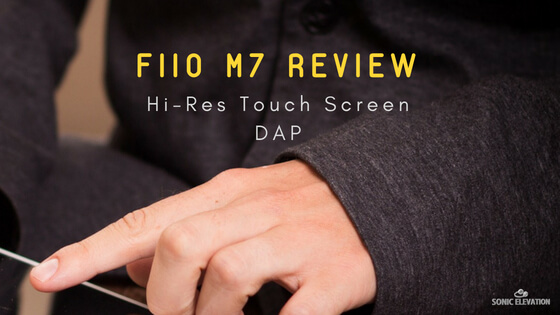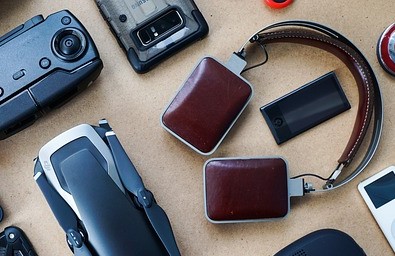
FiiO M7 Review – Hi-Res Touch Screen DAP
FiiO M7 Hi-Res Lossless Music Player
If you’re looking for a reliable and portable hi-res music player that offers a wide range of features – you came to the right place. If you can’t seem to find a sub-$200 portable player that meets your expectations, this DAP might be worth considering.
Our FiiO M7 Review will provide an extremely in-depth and unbiased look at a digital audio player that has much more to offer than you might think. The sleek touch screen navigation and wireless capabilities are just a few of the many reasons to seriously consider this DAP a strong competitor.
FiiO M7 Review


Features & Technical Specs:
- Full touch screen
- Up to 20 hours of playback on a single charge (40 days standby time)
- Charging time takes about 2.5 hours
- Hi-res wireless codec support including aptX, aptX HD, LDAC, and SBC
- Memory card expansion up to 512 GB
- Built-in Samsung Exynos 7270 Processor (to enhance power saving ability)
- Built-in FM Radio
- Includes silicone protective case and USB/USB-C cables
- USB/USB-C cable
- Made of lightweight aluminium
- Lossless File Support: FLAC, AAC, AIFF, DSD, MP3, WMA
- Line Out Frequency Response: 20 Hz – 90 kHz
- Frequency Response: 10 Hz – 90 kHz
- Output Impedance: < 2 Ohms (32 Ohms loaded)
- Recommended Headphone Impedance: 16 – 100 Ohms
- Dimensions: 4.29 x 2.05 x 0.51 in
- Weight: 4.09 ounces
Before you move on, take a quick look at the list below that you can use to navigate our review. Each section will provide an in-depth analysis of each individual performance aspect.
Here are the 7 most important sections we’ll cover in detail:
- Build Design & Portability
- Touch Screen Controls, Volume Dial, & Outside Buttons
- Is The UI Hard To Control or Intuitive?
- Battery Life Expectations – Actual Playback Time
- Wireless Connectivity & Hi-Res Codec Support
- Sonic Performance & Headphone Output Impedance
- Final Thoughts & Review Table
First, let’s take a look at this player’s build design and portability!
Build Design & Portability
The M7 has a pretty basic and straightforward design. Its aluminium chassis is extremely lightweight and obviously directed towards optimizing portable use.
Size-wise, it’s slightly slimmer and more compact than the 5 mark II
One of the main differences in build design is the placement of the front-facing metal strip directly under the power button. At first glance, it has an almost upside-down looking layout compared side by side with the FiiO X7 Mark II.
Since the metal strip sits at the top (as opposed to the bottom) it can lead first-time users to pick it up by the top at first.
You will most likely adjust pretty quickly after you sit with the DAP for a few minutes and explore the various settings and features.
An easy way to remember which side is ‘up’ is to remember that the volume dial is built-in on the upper left corner section.
Volume Dial/Portable Amp Traffic Jam
There is one minor downside to the volume dial placement. Since the volume dial is at the top of the player (on the outside left side) – it can cause a sort of ‘traffic jam between devices‘. If you’re used to using the elastic bands for attaching the two devices together, you may find that it’s not exactly ideal when pairing with most portable headphone amps.
This is mostly because the elastic band will have to either fit at the very slim empty space at the top or wrapped around the volume dial itself. Although this can be a significant drawback for some, there are a few workarounds.
FiiO designed a specialized stacking kit that can be used exclusively with the FiiO Q1 Mark II (similar to the kit pictured below).

Unless you already own a Q1 Mark II, the semi-awkward placement of the volume dial is worth keeping in mind. That is unless you don’t mind leaving your paired amp elastic band-free and only connected via the line out.
Touch Screen Controls, Volume Dial, & Outside Buttons
Although this DAP does feature a full touch screen, some of the most basic functions are performed using the buttons featured on the outside of the actual device. Before we go into more detail about each button and their respective functions, you’ll be glad to know that the touch screen is not a fingerprint magnet!

This tends to be an extremely common issue with touch screen devices that bothers some more than others. Either way, you can rest assured that when you pull the M7 out of your pocket – it won’t be covered with the same amount of finger grease you might be used to on some of the other high-end DAPs.
Buttons On The Left Side
The left side features the play/pause, skip top skip back bottom, and volume dial functions. The play/pause button is in between the skip track buttons. To skip forward, you press the top button, and vice versa to skip back.
Also on the upper end of the left side is the volume dial. The volume control dial is noticeably sturdier than the X5 3rd Gen model and has a satisfying click as you turn the volume up or down.
Buttons On The Top
The top is where you’ll find the power on/off button. It has an LED indicator light directly in the center. It will flash red when your battery life is low (or charging) and turns blue once your device is fully charged.
Also on the top is a standard 3.5 mm jack that can also function as a line out. Many DAPs and smartphones usually feature a 3.5 mm jack on the bottom end, so for some, getting used to the opposite might be a little awkward at first.
Then again, when the headphone jack is on the top, you can keep your device in your pocket and not have to worry about your headphone cable unexpectedly disconnecting. It’s not necessarily a good or bad feature, but might be slightly awkward at first if you’re not used to it.
Right Side Micro SD Card Slot
On the right side, there is a micro SD card slot that supports extended storage capacity of up to 512 GB total.
Bottom End USB Connector
The bottom end features a USB-C connector and micro USB charging port (all-in-one). The included USB-C cable can be used for charging or transferring data with other compatible devices.
Touch Screen Responsiveness & Lag
When you’re scrolling through your library searching for that one song that perfectly matches your mood, a slow and unresponsive touch screen can get annoying pretty quickly.
Although this touch screen does tend to lag a little bit when you’re scrolling through your library, it’s far from being painfully slow or unresponsive. Overall, the functional speed is pretty responsive and your album artwork loads pretty quickly after you select a song.
Developer Options Setting
If you find that it’s not as responsive as you’d like it to be, you can go into the Developer Options (under Settings) and turn the “animation settings” to off. Doing this will noticeably improve any issues you might run into with unwanted scrolling lag.
Browsing Through Your Library
As you scroll through your library, within the artist folder specifically, you’ll notice a small ‘play’ button icon to the right of each name. When you click the “play” icon directly to the right of an artist name folder, it doesn’t automatically start playing the first song.
Instead, you have to select the artist – then the album. Once you click play on the icon to the right of the album name it will start playing the first song. This will only be a slight drawback if you prefer searching your music by artist, not song name or album title.
Getting Back To The Home Screen
There is one more feature worth noting that only effects the Music app. When you’re jamming out to a great album and want to quickly return to the Home Screen of the Music app, you have to continuously swipe back until you get back to home base.
Unfortunately, there isn’t any other quick and simple way to return to the Home Screen of the Music portion of the software. Quickly accessing your music library can only be done from the Home Screen of the music app. Now, let’s take a closer look at the User Interface.
Lock Screen Functionality
Also semi-customizable are the lock screen functions. Within the key lock settings, you can customize the lock screen time, etc. Another great feature is the ability to choose which of the outside buttons you want to remain active (or inactive) while the screen is locked.
Being able to lock/unlock the outside button controls is a huge plus if you plan on keeping the M7 in your pocket while you’re listening to music. (There’s nothing worse than a DAP accidentally skipping back or forward right in the middle of one of your favorite tracks.)
When the touch screen is locked, you swipe left to unlock it and continue scrolling. There is one minor screen lock feature that may or may not bother you. It seems to be built-in to the point where if you opt to turn it off withing the settings – it will still lock while music is playing.
Once again, most of us don’t mind our screen automatically locking (and sometimes prefer that it does). If you’re one of the few who does mind, it’s a small, but possibly important feature to keep in mind.
Touch Screen Visibility & Brightness
Some players can be extremely hard to read under direct sunlight which forces you to hold your hand over the screen while you search for a song. If you manually adjust the screen brightness settings, the display will remain adequately visible under direct sunlight. Although the display brightness isn’t absolutely perfect, it easily competes with other similarly priced players.
Is The UI Hard To Control or Intuitive?
The User Interface design (much like the build) is fairly straightforward and easy to control. The operating system is Android-based and very similar past Android-based DAPs.

The home screen features 6 main sections that can be seen below:
- FiiO Music: Access your digital library, create playlists directly from your library/all songs, artists, albums, playlists, genre, folder, etc.
- FM Radio: Listen to the radio that uses your headphone cable as the antennae
- File Management: Access the file explorer for creating/managing individual folders, etc.
- Gallery: Used for viewing album artwork or other uploaded images
- Technical Support: Very similar to past android-based players – this is where you access any available firmware updates. This device only supports local updates, due to the lack of WiFi capabilities. You can also access the Quick Start Guide and a FAQ section if you need additional support.
- Settings: (This is one of the most important sections to pay attention to.) Within the Audio settings, you can manually select which Bluetooth codec you want to activate.
Here are the hi-res wireless codec settings you’ll have access to:
- LDAC – sound quality first
- LDAC – Standard
- LDAC – connection first
- aptX HD
- aptX standard
- SBC
If you’re unfamiliar with any of the wireless codecs listed above, the codec you select will depend on the model and make of your preferred Bluetooth headphones. (We’ll cover that in more detail below.) In the next section, we’ll cover installing 3rd party apps like music streaming services, etc.
Installing 3rd Party Apps
This next feature (or lack thereof) is pretty divisive and may force you to keep looking elsewhere. Unfortunately, this DAP does not have the ability to install 3rd party apps. This includes any and all popular music streaming services like Spotify, Amazon Music, or Tidal.
Whether or not that’s an instant deal-breaker depends on how you primarily listen to music. If you have a pretty hefty digital library, it clearly won’t be much of an issue. If you’ve become addicted to using streaming services and can’t see yourself consuming music any other way – this device probably won’t work for you.
Is ReplayGain Built Into The Software?
ReplayGain is a feature that is used to even out the volume levels on individual tracks across your entire library. It’s useful for saving you the trouble of having to manually adjust each track’s volume (since they weren’t recorded by the same producers or mastered at the same volume levels).
The M7 does not have a ReplayGain feature built into the software but may become available in the future as a firmware update.
Samsung Exynos Processor
This DAP features a built-in Samsung Exynos Processor processing chip. It’s also commonly-used in Samsung smartphones. What it does is help improve performance time and speed. It also improves battery efficiency which is why this player is able to last as long as it does.
Battery Life Expectations – Actual Playback Time
The M7’s battery life is advertised as lasting a total of 20 hours. In reality, you can expect to get closer to around 16 – 17 hours of continuous playback. When using an external amp the battery life is only extended by an extra 5 minutes or so.
Considering you might be using the built-in wireless features, its battery life is pretty decent compared to other FiiO DAPs and provides adequate playback time for most practical uses.
Wireless Connectivity & Hi-Res Codec Support
The wide range of wireless connectivity options and hi-res codec support on this device is unprecedented. While you may or may not have any interest in using this DAP for wireless streaming, it’s important to know that the quality of wireless audio you’ve experienced in the past is just that – a thing of the past.
We listed the various hi-res codecs above, but it might be helpful to see a little more detail on what they do and which headphones they’re compatible with. The LDAC codec was designed to be fully functional with Sony wireless headphones like the WH1000XM2.
LDAC attempts to restore lossless file compression and is able to transmit more data over a wireless connection. Essentially, it significantly enhances the quality of Bluetooth audio.
The aptX lossy codec is compatible with other Bluetooth headphones that state aptX compatibility and also performs a similar function. Many wireless Sennheiser headphones like the Sennheiser HD 4.50 are compatible with aptX and aptX HD.
It also supports Bluetooth AAC which is commonly seen in Apple devices and streaming videos on YouTube. Bluetooth AAC enables wireless data transmission that competes with best-quality MP3 formats and other lossy codecs. Some headphones support this format, and some do not.
The SBC codec is the final competing wireless enhancement technology that’s built into certain Bose headphone models (like the Bose SoundSport Free) SBC also attempts to enhance streaming quality and is only compatible with certain headphone models.
Most wireless headphones will specify which hi-res wireless codec they support, which is the easiest way to find the perfect match. There is some debate about which of the hi-res codecs produce the highest level of audio quality, but in this case – you have a variety to choose from and can run your own personal tests to decide.
Compared to past FiiO DAPs, the wireless range and connection stability are vastly improved. Overall, the Bluetooth performance easily surpasses the FiiO X3 and performs far better in terms of wireless range, connectivity, and supported Bluetooth formats.
FM Radio
There is also a built-in FM Radio that can be accessed from the main Home Screen. FM Radio has seen a huge decline in recent years so this feature might’ve been added for nostalgic purposes. The actual audio quality has quite a bit of static and is honestly pretty unnecessary for most listeners.
Maybe you enjoy scanning the radio to find your favorite station, maybe you don’t. Either way, you do have the option if you choose to use it.
Sonic Performance & Headphone Output Impedance
Although much of the audio quality you experience relies on the files you add, which wireless codec you use, and your preferred pair of cans – this DAP does have a few distinct playback characteristics.

Most of the music you listen to on this device will have a smooth and balanced tonal quality. The M7 doesn’t go out of its way to add unnecessary coloration or any audible distortion at all. This is why the playback you experience will sound very natural and true-to-the-track.
If you prefer open-back headphones that have a strong neutral sound profile – you should be more than happy with the playback that’s produced.
The headphone output impedance level allows for most headphones and/or IEMs to be easily driven and well represented. No matter which pair of cans you decide to connect with via Bluetooth (or the wired connection) – you can rest assured that your songs won’t sound over-bloated, muddy, or otherwise noticeably inaccurate.
Final Thoughts & Review Table
When it comes to portable digital audio players, this specific model is widely considered to be one of the best from FiiO so far. For a DAP in this price range, it’s nearly impossible to find the same wide range of wireless features and hi-res Bluetooth codec support.
If you don’t view the wireless options and hi-res codecs to be that appealing or essential, you can always use the wired connection to experience the neutral and smooth playback this device has to offer. (Who knows, you might decide to participate in the wave of wireless technology.)
As long as you can overlook the minor volume dial/portable amp design flaw and don’t mind living without Spotify – you will be extremely satisfied with the performance of this DAP. Although the extensive Bluetooth features are just the cherry on top, it would be hard to pass up on the opportunity to have so many options in the palm of your hand.
Take one final look at the review table below to see a final pros/cons checklist and the most important rating criteria we used to calculate its overall score.
If you have any questions about any of the features covered here, feel free to ask in the comment section below. We look forward to hearing from you and always do our best to respond as quickly as we can!
If all (or most) of the features we covered in our FiiO M7 review made the gears in your head start to turn, use the link here or click the button at the bottom of the review table to check the most current pricing info on Amazon.
Thanks for stopping by to check out our review! We hope to see you here again!
- Korg B2 vs Roland FP10 | Which One To Buy - May 13, 2021
- How Does Music Affect The Brain? – Let’s Find Out! - April 6, 2021
- Why Are My Headphones Crackling? – How To Fix It - April 3, 2021
